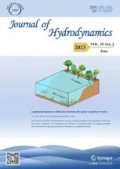Abstract
In this paper, an artificial neural network (ANN) trained through a deep reinforcement learning (DRL) agent is used to perform flow control. The target is to look for the wake stabilization mechanism in an active way. The flow past a 2-D cylinder with a Reynolds number 240 is addressed with and without a control strategy. The control strategy is based on using two small rotating cylinders which are located at two symmetrical positions back of the main cylinder. The rotating speed of the counter-rotating small cylinder pair is determined by the ANN and DRL approach. By performing the final test, the interaction of the counter-rotating small cylinder pair with the wake of the main cylinder is able to stabilize the periodic shedding of the main cylinder wake. This demonstrates that the way of establishing this control strategy is reliable and viable. In another way, the internal interaction mechanism in this control method can be explored by the ANN and DRL approach.
Similar content being viewed by others
References
Williamson C. H. K., Govardhan R. Vortex-induced vibrations [J]. Annual Review of Fluid Mechanics, 2004, 36: 413–455.
Bearman P. W. Investigation of the flow behind a two-dimensional model with a blunt trailing edge and fitted with splitter plates [J]. Journal of Fluid Mechanics, 1965, 21: 241–255.
Bearman P. W., Owen J. C. Reduction of bluff-body drag and suppression of vortex shedding by the introduction of wavy separation lines [J]. Journal of Fluids and Structures, 1998, 12(1): 123–130.
Bagheri S., A Mazzino A., Bottaro A. Spontaneous symmetry breaking of a hinged flapping filament generates lift [J]. Physical Review Letters, 2012, 109(15): 154502.
Deng J., Mao X., Xie F. Dynamics of two-dimensional flow around a circular cylinder attached with flexible filaments [J]. Physical Review E, 2019, 100: 053107.
Choi H., Jeon W. P., Kim J. Control of flow over a bluff body [J]. Annual Review of Fluid Mechanics, 2008, 40: 113–139.
Poncet P. Topological aspects of three-dimensional wakes behind rotary oscillating cylinders [J]. Journal of Fluid Mechanics, 2004, 517: 27–53.
Cetiner O., Rockwell D. Streamwise oscillations of a cylinder in a steady current. Part 1. Locked-on states of vortex formation and loading [J]. Journal of Fluid Mechanics, 2001, 427: 1–28.
Leontini J. S., Jacono D. L., Thompson M. C. Wake states and frequency selection of a streamwise oscillating cylinder [J]. Journal of Fluid Mechanics, 2013, 730: 162–192.
Blackburn H. M., Henderson R. D. A study of two-dimensional flow past an oscillating cylinder [J]. Journal of Fluid Mechanics, 1999, 385: 255–286.
Chauhan M. K., Dutta S., Gandhi B. K. et al. Experimental investigation of flow over a transversely oscillating square cylinder atintermediate Reynolds number [J]. Journal of Fluids Engineering, 2016, 138(5): 051105.
Artana G., Sosa R., Moreau E. et al. Control of the near-wake flow around a circular cylinder with electro hydrodynamic actuators [J]. Experiments in Fluids, 2003, 35: 580–588.
Kim J., Choi M. H. Distributed forcing of flow over a circular cylinder [J]. Physics of Fluids, 2005, 17(3): 033103.
Chen W. L., Li H., Hu H. An experimental study on a suction flow control method to reduce the unsteadiness of the wind loads acting on a circular cylinder [J]. Experiments in Fluids, 2014, 55: 1707.
Sohankar A., Khodadadi M., Rangraz E. Control of fluid flow and heat transfer around a square cylinder by uniform suction and blowing at low Reynolds numbers [J]. Computers and Fluids, 2015, 109: 155–167.
Mittal S. Control of flow past bluff bodies using rotating control cylinders [J]. Journal of Fluids and Structures, 2001, 15(2): 291–326.
Zhu H., Yao J., Ma Y. et al. Simultaneous CFD evaluation of VIV suppression using smaller control cylinders [J]. Journal of Fluids and Structures, 2015, 57: 66–80.
Schulmeister J. C., Dahl J. M., Weymouth G. D. et al. Flow control with rotating cylinders [J]. Journal of Fluid Mechanics, 2017, 825: 743–763.
Rabault J., Kuchta M., Jensen A. et al. Artificial neural networks trained through deep reinforcement learning discover control strategies for active flow control [J]. Journal of Fluid Mechanics, 2019, 865: 281–302.
Schmidhuber J. Deep learning in neural networks: An overview [J]. Neural Networks, 2015, 61: 85–117.
Nathan Kutz J. Deep learning in fluid dynamics [J]. Journal of Fluid Mechanics, 2017, 814: 1–4.
Wang Z., Xiao H., Fang F. et al. Model identification of reduced order fluid dynamics systems using deep learning [J]. International Journal for Numerical Methods in Fluids, 2018, 86(4): 255–268.
Verma S., Novati G., Koumoutsakos P. Efficient collective swimming by harnessing vortices through deep reinforcement learning [J]. Proceedings of the National Academy of Sciences, 2018, 115(23): 5849–5854.
Cai S., Zhou S., Xu C. et al. Dense motion estimation of particle images via a convolutional neural network [J]. Experiments in Fluids, 2019, 60: 73.
Rabault J., Kolaas, J., Jensen, A. Performing particle image velocimetry using artificial neural networks: a proof-of-concept [J]. Measurement Science and Technology, 2017, 28(12): 125301.
Schulman J., Wolski F., Dhariwal P. et al. Proximal policy optimization algorithms [EB/OL]. arXiv preprint, 2017, arXiv:1707.06347.
Rabault J., Kuhnle A. Accelerating deep reinforcement learning of active flowcontrol strategies through a multi-environment approach [J]. Physics of Fluids, 2019, 31(9): 094105.
Valen-Sendstad K., Logg A., Mardal K. A. et al. A comparison of finite element schemes for the incompressible Navier-Stokes equations (Automated solution of differential equations by the finite element method [M]. Berlin, Germany: Springer, 2012, 399–420.
Goda K. A multistep technique with implicit difference schemes for calculating two-or three-dimensional cavity flows [J]. Journal of Computational Physics, 1979, 30(1): 76–95.
Acknowledgement
The authors would like to acknowledge supports from National Numerical Wind Tunnel Project (Grant No. NNW2019ZT4-B09).
Author information
Authors and Affiliations
Corresponding author
Additional information
Project supported by the National Natural Science Foundation of China (Grant Nos. 91852117, 91852106).
Rights and permissions
About this article
Cite this article
Xu, H., Zhang, W., Deng, J. et al. Active flow control with rotating cylinders by an artificial neural network trained by deep reinforcement learning. J Hydrodyn 32, 254–258 (2020). https://doi.org/10.1007/s42241-020-0027-z
Received:
Revised:
Accepted:
Published:
Issue Date:
DOI: https://doi.org/10.1007/s42241-020-0027-z




